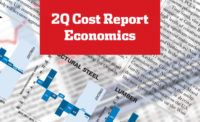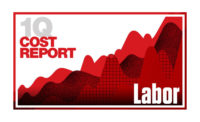2Q Cost Report
After Absorbing Hits, Construction Costs Show Signs of Rising
Labor markets still deal with the lingering impacts of the most recent recession

A year ago, ENR pondered the impact of two big events: the U.K.’s Brexit vote to leave the European Union and the U.S. government’s ruling to increase the tariffs on Chinese cold-rolled flat steel by 522%. As the magazine predicted, neither move had much effect on construction costs. However, another inflationary sleeper, wage costs, is starting to arise. Most labor markets are still dealing with the impact of the last recession, which drove out many skilled workers from the industry. How contractors are meeting that challenge is the major driver of today’s costs.
“After more than a decade of flat wage increases in the Davis-Bacon wages we track, we are all of a sudden seeing increases of more than 4%,” says Bill Mahoney, president of BNI, which publishes cost-consulting books.
Since the recession, people are starting to come back but they are underskilled, says Julian Anderson, president of Rider Levett Bucknall. “The result is a growing productivity gap, which is starting to show in our numbers,” he adds. RLB puts together a seller’s cost index, published by ENR (see table page 21), which is up 4.8% for the year.
View the full ENR 2017 2Q Cost Report PDF
Labor costs are a major problem, especially with the strong growth we are seeing on the West Coast,” says Mary Wallers, president of Sierra West. “It may take up to two years for things to work out.” She adds that “lumber prices are really jumping” and subcontractor costs are driving inflation. In the current quarter, Sierra West’s general building cost index is up 3.1% for the year, while their selling price index, which includes subcontractor bids, is up 7.8% over April 2016’s level.
“Subs are putting in premiums for risk due to the lack of available labor,” says Sierra West’s chief estimator John Moreno. Everybody has enough work in their backyard, so they don’t have to travel, which reduces competition in some markets, he says.
“We are seeing strong year-over-year gains in construction costs,” says Brad Saylor, president of Leland Saylor, which publishes two indexes in ENR. In the latest quarter Saylor’s material-labor index is up 3.6% for the year, while its subcontractor index is up just 2.5%. “We found the difference a bit of a surprise, but we think there is more competition in the subcontractor bids and higher pressure on material prices,” he says. Oil-based materials, such as paint, roofing and insulation, are particularly troublesome, he adds.
IHS Global Insight’s forecasts are taking into account the unexpected election of Donald Trump as U.S. president. Trump’s infrastructure campaign promises now look like a “bump in fiscal stimulus that may not be coming,” says John Mothersole, president of the consultant’s construction price forecasting division.
“Overall, we saw a big rise in costs in 2016, but the tone is changing,” Mothersole adds. “The expectation that growth in China would improve seems questionable now, and there is a feeling that there won’t be a soft landing for the Chinese market,” he says. Weakness in China would put a major drag on global commodity prices.
“China has a glut in flat-steel and rebar products,” says John Anton, steel analyst for Global Insight. “They are oversupplied and badly misjudged demand,” he says. As a result, he predicts that there is a downward bias to steel prices and says it is becoming more of a buyer’s market. “Buy on spot and wait for prices to fall,” is his advice.
Anton forecasts rebar will increase about 3.3% this year, after falling 25.7% during the two previous years. In 2018, he expects prices to slip 0.2%. Structural steel follows suit, which is forecast to increase just 2.9% this year, following a 14.7% decline during the previous two years. Next year, Anton predicts that structural steel prices will be rolled back by 2%.
“The steady rise in cement prices continues to surprise us,” says Deni Koenhemsi, construction materials analyst for IHS Global Insight. “Supply is not keeping up with demand,” she says. A large number of cement kilns were idled during the recession, she says, and restarting them under new regulations is very expensive. To compensate, firms are importing more expensive cement rather than the cheaper clinker. Prices have risen more than 4% a year for the period between 2013 and 2017 and IHS Global Insight is looking for another 3.8% increase in 2018.
This year, ENR introduced two new building cost indexes, compiled by the U.S. Commerce Dept., to its table of 16 major industry indexes. Both new indexes show very modest annual cost increases of 0.6% for industrial buildings, while the medical-building cost index showed no gain for the year. This compares to annual increases of 1.7% for warehouses and 1.6% for office buildings. In addition, Commerce’s cost index for residential-building work is up 5.3% for the year.




